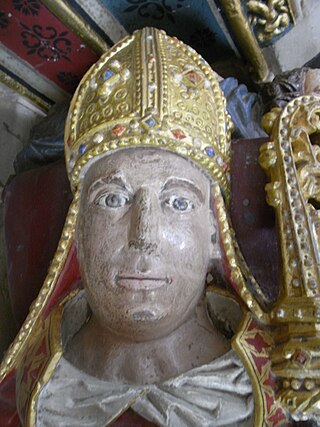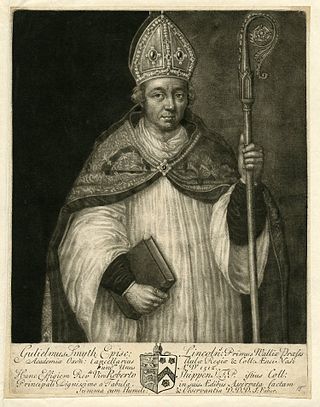
Peterhouse is the oldest constituent college of the University of Cambridge in England, founded in 1284 by Hugh de Balsham, Bishop of Ely. Today, Peterhouse has 254 undergraduates, 116 full-time graduate students and 54 fellows. It is quite often erroneously referred to as Peterhouse College, although the correct name is simply Peterhouse.

St John's College is a constituent college of the University of Cambridge founded by the Tudor matriarch Lady Margaret Beaufort. In constitutional terms, the college is a charitable corporation established by a charter dated 9 April 1511. The full formal name of the college is the College of St John the Evangelist in the University of Cambridge. The aims of the college, as specified by its statutes, are the promotion of education, religion, learning and research. It is one of the largest Oxbridge colleges in terms of student numbers. For 2022, St John's was ranked 6th of 29 colleges in the Tompkins Table with over 35 per cent of its students earning first-class honours. It is the second wealthiest college in Oxford and Cambridge, after neighbouring Trinity, at Cambridge.

Lady Margaret Beaufort was a major figure in the Wars of the Roses of the late fifteenth century, and mother of King Henry VII of England, the first Tudor monarch.

John Fisher was an English Catholic bishop, cardinal, and theologian. Fisher was also an academic and Chancellor of the University of Cambridge. He was canonized by Pope Pius XI.

Hugh Oldham was an English cleric who was Bishop of Exeter (1505–19) and a notable patron of education as a founder and patron of Manchester Grammar School and Corpus Christi College, Oxford.
Thomas Watson was a Catholic Bishop, notable among Catholics for his descriptions of the Protestant Reformation. Historian Albert Pollard described Watson as "one of the chief Catholic controversialists" of Mary Tudor's reign.

The Ascension Parish Burial Ground, formerly known as the burial ground for the parish of St Giles and St Peter's, is a cemetery off Huntingdon Road in Cambridge, England. Many notable University of Cambridge academics are buried there, including three Nobel Prize winners.

William Smyth was Bishop of Coventry and Lichfield from 1493 to 1496 and then Bishop of Lincoln until his death. He held political offices, the most important being Lord President of the Council of Wales and the Marches. He became very wealthy and was a benefactor of a number of institutions. He was a co-founder of Brasenose College, Oxford and endowed a grammar school in the village of his birth in Lancashire.

The House of Beaufort is an English noble and quasi-royal family, which originated in the fourteenth century as the legitimated issue of John of Gaunt, 1st Duke of Lancaster and his long time mistress Katherine Swynford. Gaunt and Swynford had four children: John Beaufort, 1st Earl of Somerset (1373–1410); Cardinal Henry Beaufort, (1375–1447), Bishop of Winchester; Thomas Beaufort, Duke of Exeter (1377–1426) and Joan Beaufort, Countess of Westmorland (1379–1440). When Gaunt finally married Swynford as his third wife in 1396, the Beaufort children were legitimized by Pope Boniface IX and by royal proclamation of the reigning monarch King Richard II, who was John of Gaunt’s nephew.
Queen Elizabeth's School is a co-educational secondary school in Wimborne Minster, Dorset, England.
Events from the 1500s in England.
Francis Mallet was an English churchman and academic, and chaplain to Mary Tudor.
Nicholas Metcalfe was an English churchman and college head.

Robert Shorton was an English churchman and academic, first Master of St John's College, Cambridge and Archdeacon of Bath.
William Franklyn (1460–1556) was an English churchman, who became dean of Windsor.
William Buckmaster was an English cleric and academic, three times vice-chancellor of the University of Cambridge.

Meynnart Wewyck or Maynard Vewicke was a Netherlandish painter, active ca. 1502–1525 in England and Scotland, where he was known as "Maynard" and "Mynours". Wewyck was employed as an artist at the court of Henry VII of England and, after his death, by his son Henry VIII. He also spent a brief period at the court of James IV of Scotland. Surviving documentation associates Wewyck with portraits of several members of the royal family, and with drawings for the tomb of Lady Margaret Beaufort, mother of Henry VII, at Westminster Abbey. New research published in 2019 has identified a portrait of Lady Margaret Beaufort in the Master's Lodge at St John's College, Cambridge as by Wewyck, and also attributes a painting of Henry VII at the Society of Antiquaries of London to his hand. In follow-on work, a group of researchers suggests that four surviving portraits of Henry VIII and two of his mother, Elizabeth of York, should also be attributed to Wewyck.
William Burgoyne was an English priest and academic at the University of Cambridge, who served as Lady Margaret's Professor of Divinity and Master of Peterhouse, Cambridge.










